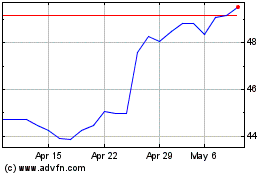Companies Take a Piecemeal Approach to Automation Tech
April 04 2019 - 1:14PM
Dow Jones News
By Angus Loten
The growth of artificial intelligence, robotics and other
next-generation automation technologies are prompting some
corporate leaders to ask age-old business questions: How much
should we pay for this? And who is in charge?
These and other issues are among the obstacles to fully
deploying such tools cited by nearly 600 chief information
officers, tech and business directors, and other C-suite executives
surveyed by KPMG LLP.
Together they represent firms in a range of industries
world-wide, each with $1 billion or more in revenue -- including
nearly two dozen with revenue above $10 billion, according to
KPMG.
Roughly 30% said their companies have allocated $50 million or
more to smart automation projects, and more than half have already
spent at least $10 million. The initiatives include various
combinations of robotic process automation, artificial
intelligence, machine learning, cognitive computing and
analytics.
"Once a foundational investment is made in tools, staffing,
process redesign and core infrastructure including cloud, they can
be applied across a wide-ranging scope of applications and
functions to achieve scale," Cliff Justice, KPMG's head of
intelligent automation, told CIO Journal.
So far, funding is being channeled into corporate finance and
accounting functions, followed by group benefits strategies and
compliance, and industry-specific core operations, the survey
found. Other areas included supply chain and procurement and human
resources.
More than half of the officials surveyed said their firm's key
strategic goal for implementing these tools is to improve or
streamline customer services and front-office effectiveness.
Roughly a quarter said their goal is to drive revenue growth.
Yet most of these efforts are still in the pilot-project phase.
Only 17% of surveyed officials said their firms have smart
automation technologies operating at full scale. As many as 30%
haven't begun investing in smart technologies or are unsure of
their plans.
Among the top three obstacles identified as holding back full
deployments was a lack of resources -- from storage to staffing --
necessary to build up smart technologies, the survey found.
Efforts also suffer through "inadequate change management and
governance, lack of senior management sponsorship or lack of
alignment of AI goals with overall corporate objectives," Mr.
Justice said.
Similarly, the next biggest hurdles were uncertainty about the
amount of spending needed to make these deployments worthwhile,
followed by a lack of "organizational clarity and accountability"
to drive implementation projects.
That is prompting many companies to take a more piecemeal
approach to smart automation, the survey found.
"The more 'moonshot' approaches to artificial intelligence or
smart technologies have been cooling off over the last two years,"
said Craig Le Clair, vice president and principal analyst at
Forrester Inc. for enterprise architecture and business process
professionals.
He said large deployments often require data science and machine
learning expertise -- adding to recruiting costs -- while tending
to have less clear timelines or business objectives.
Instead, many firms are finding a better return on investments
in limited deployments of smart-tech building blocks, such as bots
that mimic and replace low-value and repetitive tasks, Mr. Le Clair
said.
Because smart-tech projects typically span different corporate
divisions, they can include multiple corporate leaders.
The survey found that 43% of smart technologies deployments are
led by IT units, and less than one-fifth involved IT and business
units working together. "This scenario makes for a less than ideal
outcome if a limited number of departments actually get involved,"
KPMG said.
Michael Clementi, vice president of human resources for North
America at Unilever PLC, said the key to successfully deploying
smart technologies is getting people from across the business to
work together.
Unilever recently used an AI-enabled application to identify
promising job applicants, replacing a monthslong college-recruiting
process.
Rather than lead smart-tech projects, chief executives and other
top company officials should identify business problems that need
to be solved. Tech and business unit leaders can then get together
to assess the ability of smart tools to fix those problems, he
said.
"There's a big conversation constantly about how we can
fast-track this technology," Mr. Clementi said this week at the WSJ
Pro Artificial Intelligence Executive Forum.
Write to Angus Loten at angus.loten@wsj.com
(END) Dow Jones Newswires
April 04, 2019 12:59 ET (16:59 GMT)
Copyright (c) 2019 Dow Jones & Company, Inc.
Unilever (EU:UNA)
Historical Stock Chart
From Mar 2024 to Apr 2024

Unilever (EU:UNA)
Historical Stock Chart
From Apr 2023 to Apr 2024
